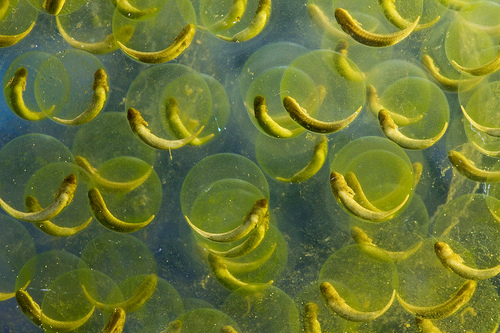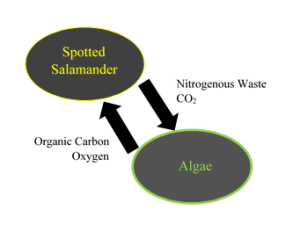Oophila amblystomatis: Difference between revisions
| (17 intermediate revisions by 3 users not shown) | |||
| Line 8: | Line 8: | ||
Order: Chlorococcales, | Order: Chlorococcales, | ||
Family: Chlorococcaceae, | Family: Chlorococcaceae, | ||
Genus: Oophila, | Genus: ''Oophila'', | ||
Species: O. amblystomatis | Species: ''O. amblystomatis'' | ||
==Description and Significance== | ==Description and Significance== | ||
[[File:Oophila2.jpg|Type|Border|right|super|size|link=Link|alt=Alt|lang=Langtag|Caption]] ''Oophila amblystomatis'' is a single celled green algae. It is only found in the eggs of the salamander, ''Ambystoma maculatum''. The salamander's eggs are typically laid in temporary, small, woodland ponds where decaying leaves and other detritus are present; therefore, these are the areas where ''Oophila amblystomatis'' can be found (Gilbert 1944). These environments are typically low in oxygen concentration. By producing oxygen as the byproduct of photosynthesis, the green algae increases oxygen concentrations within the eggs they inhabit conferring fitness benefits to the salamander embryo hosts. A study found that salamander eggs inhabited by the green algae exhibit lower mortality, earlier hatching time and faster growth (Gilbert 1944). The green algae benefit by metabolizing the nitrogenous waste produced by the embryos as well as utilizing the CO2 produced by the respiration of the salamander embryos. Experiments of the green algae in the presence and absence of an embryo found that the green algae grew more vigorously when embryos were present (Gilbert 1944). Because both the green algae and the salamander embryos in eggs benefit, this is an example of a mutualistic relationship. | |||
==Genome Structure== | ==Genome Structure== | ||
Both the 16S rRNA gene and 18S rRNA gene of ''Oophila amblyostomatis'' have been partially sequenced. The entire genome of this organism has not been sequenced. | |||
==Cell Structure, Metabolism and Life Cycle== | ==Cell Structure, Metabolism and Life Cycle== | ||
''O. amblystomatis'' is classified as a plant cell, which means that it contains not only the all the organelles of a eukaryotic cell, but also chloroplasts, pyreniods, and starch. These cells also have flagella, which help the cell travel through the water to enter the eggs of the spotted salamander (''Ambystoma maculatum''). Chloroplasts being contained in the cell signifies that the cell performs photosynthesis, converting carbon dioxide, which is provided by the salamander embryos undergoing respiration, to oxygen, and this makes the organism a photoautotroph. ''O. amblystomatis'' undergoes the same life cycle as other single-celled ''Chlamydomonas'', going through both asexual and sexual reproduction. | |||
==Ecology== | ==Ecology== | ||
Oophila amblystomatis is a single-celled green algae that can only be found | [[File:Oophila1.png|Type|Border|right|super|Size|link=Link|alt=Alt|lang=Langtag|Caption]] ''Oophila amblystomatis'' is a single-celled green algae that can only be found inside of the spotted salamander (''Ambystoma maculatum'') eggs. It is not present anywhere else in nature. The algae grows alongside the salamander within the enclosed egg and provides the green color that is present. The algae more specifically, in the presence of light, uses the process of photosynthesis and provides higher oxygen concentrations to the egg. However, in the absence of light, the oxygen levels are extremely low within the egg. The spotted salamander egg provides nitrogenous waste CO2 to the algae, and the algae in return provides the salamander organic carbon and oxygen. This creates the mutualistic relationship between the two (Bachmann 1986). | ||
==References== | ==References== | ||
Bachmann, Marilyn D., Burkholder, JoAnn M., Carlton, Richard G., & Wetzel, Robert G.(1986).Symbiosis between salamander eggs and green algae: microelectrode measurements inside eggs demonstrate effect of photosynthesis on oxygen concentration. Canadian Journal of Zoology, 64(7): 1586-1588. | Bachmann, Marilyn D., Burkholder, JoAnn M., Carlton, Richard G., & Wetzel, Robert G.(1986).Symbiosis between salamander eggs and green algae: microelectrode measurements inside eggs demonstrate effect of photosynthesis on oxygen concentration. ''Canadian Journal of Zoology'', 64(7): 1586-1588. | ||
Gilbert, P. W., 1944. The alga-egg relationship in Ambystoma maculatum, a case of symbiosis. ''Ecol.'', 25: 366-369 | |||
Gilbert, P. W. (1942). Observations on the eggs of Ambystoma maculatum with especial reference to the green algae found within the egg envelopes. ''Ecology''. 23 (2): 215–227. | |||
Hutchison, V. H., & Hammen, C. S. (1958). Oxygen utilization in the symbiosis of embryos of the salamander, Ambystoma maculatum and the alga, Oophila amblystomatis. The Biological Bulletin, 115(3), 483-489 | Hutchison, V. H., & Hammen, C. S. (1958). Oxygen utilization in the symbiosis of embryos of the salamander, Ambystoma maculatum and the alga, Oophila amblystomatis. ''The Biological Bulletin, 115(3)'', 483-489 | ||
==Author== | ==Author== | ||
Page authored by | Page authored by Avery Quinlan, Max Zaret, & Jessica Zellinger students of Prof. Jay Lennon at IndianaUniversity. | ||
<!-- Do not remove this line-->[[Category:Pages edited by students of Jay Lennon at Indiana University]] | <!-- Do not remove this line-->[[Category:Pages edited by students of Jay Lennon at Indiana University]] | ||
Latest revision as of 17:09, 25 April 2018
Classification
Domain: Eukaryota, Kingdom: Plantae, Division: Chlorophyta, Class: Chlorophyceae, Order: Chlorococcales, Family: Chlorococcaceae, Genus: Oophila, Species: O. amblystomatis
Description and Significance
Oophila amblystomatis is a single celled green algae. It is only found in the eggs of the salamander, Ambystoma maculatum. The salamander's eggs are typically laid in temporary, small, woodland ponds where decaying leaves and other detritus are present; therefore, these are the areas where Oophila amblystomatis can be found (Gilbert 1944). These environments are typically low in oxygen concentration. By producing oxygen as the byproduct of photosynthesis, the green algae increases oxygen concentrations within the eggs they inhabit conferring fitness benefits to the salamander embryo hosts. A study found that salamander eggs inhabited by the green algae exhibit lower mortality, earlier hatching time and faster growth (Gilbert 1944). The green algae benefit by metabolizing the nitrogenous waste produced by the embryos as well as utilizing the CO2 produced by the respiration of the salamander embryos. Experiments of the green algae in the presence and absence of an embryo found that the green algae grew more vigorously when embryos were present (Gilbert 1944). Because both the green algae and the salamander embryos in eggs benefit, this is an example of a mutualistic relationship.
Genome Structure
Both the 16S rRNA gene and 18S rRNA gene of Oophila amblyostomatis have been partially sequenced. The entire genome of this organism has not been sequenced.
Cell Structure, Metabolism and Life Cycle
O. amblystomatis is classified as a plant cell, which means that it contains not only the all the organelles of a eukaryotic cell, but also chloroplasts, pyreniods, and starch. These cells also have flagella, which help the cell travel through the water to enter the eggs of the spotted salamander (Ambystoma maculatum). Chloroplasts being contained in the cell signifies that the cell performs photosynthesis, converting carbon dioxide, which is provided by the salamander embryos undergoing respiration, to oxygen, and this makes the organism a photoautotroph. O. amblystomatis undergoes the same life cycle as other single-celled Chlamydomonas, going through both asexual and sexual reproduction.
Ecology
Oophila amblystomatis is a single-celled green algae that can only be found inside of the spotted salamander (Ambystoma maculatum) eggs. It is not present anywhere else in nature. The algae grows alongside the salamander within the enclosed egg and provides the green color that is present. The algae more specifically, in the presence of light, uses the process of photosynthesis and provides higher oxygen concentrations to the egg. However, in the absence of light, the oxygen levels are extremely low within the egg. The spotted salamander egg provides nitrogenous waste CO2 to the algae, and the algae in return provides the salamander organic carbon and oxygen. This creates the mutualistic relationship between the two (Bachmann 1986).
References
Bachmann, Marilyn D., Burkholder, JoAnn M., Carlton, Richard G., & Wetzel, Robert G.(1986).Symbiosis between salamander eggs and green algae: microelectrode measurements inside eggs demonstrate effect of photosynthesis on oxygen concentration. Canadian Journal of Zoology, 64(7): 1586-1588.
Gilbert, P. W., 1944. The alga-egg relationship in Ambystoma maculatum, a case of symbiosis. Ecol., 25: 366-369
Gilbert, P. W. (1942). Observations on the eggs of Ambystoma maculatum with especial reference to the green algae found within the egg envelopes. Ecology. 23 (2): 215–227.
Hutchison, V. H., & Hammen, C. S. (1958). Oxygen utilization in the symbiosis of embryos of the salamander, Ambystoma maculatum and the alga, Oophila amblystomatis. The Biological Bulletin, 115(3), 483-489
Author
Page authored by Avery Quinlan, Max Zaret, & Jessica Zellinger students of Prof. Jay Lennon at IndianaUniversity.


